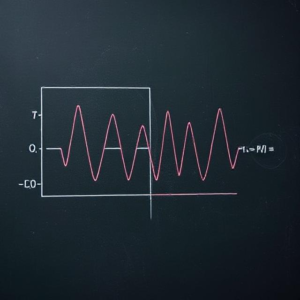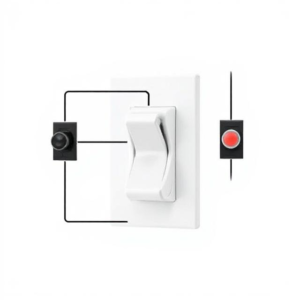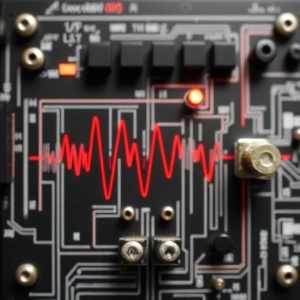What is Time-Domain Analysis?
Time-domain analysis is a method used to study how voltages and currents in a circuit change over time. Instead of looking at the circuit’s behavior only at a single point in time or at steady conditions (like DC circuits), time-domain analysis shows how the circuit responds to changes, such as when a signal is applied or when there’s a sudden change in the circuit (like turning on a switch).

In simpler terms: Time-domain analysis helps us understand how electrical signals evolve over time in a circuit.
Why is Time-Domain Analysis Important?
It’s crucial because most real-world circuits deal with signals that change over time (such as audio signals, radio signals, or even the current and voltage changes when you flip a switch). For example:
- In an audio amplifier, the input is a sound signal that varies over time, and we want to understand how the circuit responds to that signal.
- In a digital circuit, signals change quickly, and time-domain analysis helps us understand the circuit’s behavior as those signals switch on and off.
How Does Time-Domain Analysis Work?
When we perform time-domain analysis, we look at how voltages and currents vary with time when different input signals (like voltages or currents) are applied to a circuit. We also study how the circuit responds to these changes.
- Step Response:
- One common method of time-domain analysis is to see how the circuit reacts to a step input, like turning on a voltage source suddenly.
- A step input is when a voltage suddenly switches from 0 volts to a constant value (like flipping a switch).
- The circuit will react by changing its voltage or current over time.
- Example: Think of a light bulb. If you suddenly turn on the switch, the brightness of the bulb doesn’t immediately reach its full brightness; it takes time for the current to flow and the filament to heat up.
- Impulse Response:
- The impulse response shows how a circuit responds to a very short, sharp input signal, often represented by an impulse (a very short burst of current or voltage).
- This is important in systems that need to respond quickly, such as communication circuits.
- The impulse response helps predict how the circuit will behave for other more complex inputs.
- Transient Response:
- Transient response refers to how a circuit reacts immediately after a sudden change (like turning on a switch) before it settles into a steady state.
- Transients are the temporary behaviors that occur as the circuit moves from one state to another.
- After the transient response, the circuit usually reaches a steady-state where the voltage and current don’t change much anymore.
- Example: When you charge a capacitor, the current and voltage will change in a way that depends on the circuit’s properties, like resistance and capacitance. This is the transient response.
- Steady-State:
- Steady-state is the condition where the circuit’s voltages and currents no longer change with time. After the transient effects have worn off, the circuit reaches a stable operating point.
- For example, when you’ve fully charged a capacitor, it stops changing, and the voltage across it stays constant.
Key Components in Time-Domain Analysis:
- Resistors (R):
- A resistor limits the current flow, and in time-domain analysis, the resistor determines how quickly the voltage across the circuit changes.
- The voltage across a resistor is directly related to the current passing through it, and the time it takes for the current to build up depends on the resistance.
- Capacitors (C):
- A capacitor stores energy in the form of an electric field. In time-domain analysis, capacitors affect how quickly the voltage in a circuit changes over time.
- For example, when charging a capacitor, the voltage across it increases over time until it reaches a maximum value.
- The charging and discharging of capacitors can create slow changes or exponential curves in the voltage.
- Inductors (L):
- An inductor stores energy in a magnetic field and resists sudden changes in current. It affects how the current behaves over time.
- When current is suddenly applied to an inductor, the inductor “fights” against the sudden change, and the current gradually increases (rather than jumping to a value instantly).
Example of Time-Domain Analysis:
Let’s say you have a simple RC circuit (a resistor and capacitor in series), and you suddenly apply a voltage to it (a step input).
- At first (the transient response), the capacitor will start charging. The current through the circuit will be high at first and gradually decrease as the capacitor charges up.
- Over time, the voltage across the capacitor will increase, but it won’t jump to the final value instantly. It will approach the final value following a curve, which is known as an exponential rise.
- After a long time, the capacitor will be fully charged (steady state), and the current will drop to zero.
Time-Domain Equations:
For circuits with components like resistors, capacitors, and inductors, the relationship between voltage and current can be described using differential equations. These equations describe how voltages and currents change over time in the circuit.
For example, in an RC circuit:
- The voltage across the capacitor (V) changes over time based on the current flowing through the resistor (R) and the capacitance (C).
- The time constant (τ = RC) determines how fast the capacitor charges or discharges. The larger the time constant, the slower the change in voltage across the capacitor.
Time-Domain vs. Frequency-Domain:
- Time-domain analysis focuses on how the circuit behaves over time.
- Frequency-domain analysis focuses on how the circuit responds to different frequencies, like sine waves or oscillations.
While time-domain analysis is great for understanding how a circuit reacts to sudden changes or step inputs, frequency-domain analysis is useful for understanding how the circuit behaves when exposed to periodic signals.
Summary:
- Time-domain analysis helps us understand how voltages and currents in a circuit change over time.
- It involves studying the circuit’s transient response (how the circuit reacts to sudden changes) and the steady-state (when the circuit has settled into a stable condition).
- Key components like resistors, capacitors, and inductors influence how the circuit behaves over time.
- Time-domain analysis is used in many real-world applications, such as audio systems, communication circuits, and power supplies, to see how signals and currents evolve over time.











